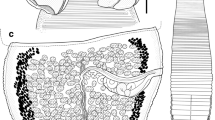Abstract
Alexandercestus n. g. (Cestoda: Tetraphyllidea) is erected for two cestode species found parasitising the two known species of lemon sharks (Carcharhiniformes: Negaprion spp.). This new genus differs from all other phyllobothriid genera except for Hemipristicola Cutmore, Theiss, Bennett & Cribb, 2011, Marsupiobothrium Yamaguti, 1952, Nandocestus Reyda, 2008, Orectolobicestus Ruhnke, Caira & Carpenter 2006, Orygmatobothrium Diesing, 1863, Paraorygmatobothrium Ruhnke, 1994 and Phyllobothrium van Beneden, 1849 in possessing uniloculate bothridia with an apical sucker and neck scutes. Alexandercestus differs from Orectolobicestus and Nandocestus in lacking marginal loculi on the bothridia, from Paraorygmatobothrium in possessing uninterrupted vitelline follicles at the level of the ovary and from Phyllobothrium in being euapolytic as opposed to anapolytic and in lacking posteriorly bifid bothridia. The new genus lacks the central accessory bothridial organ seen in specimens of Orygmatobothrium, and lacks the central bothridial accessory sucker of specimens of Marsupiobothrium. Alexandercestus spp. compare most favourably with specimens of Hemipristicola, especially with respect to aspects of proglottid morphology, but differ in possessing aristate gladiate spinitriches rather than serrate gladiate spinitriches on the proximal bothridial surface. In addition, the bothridia of Alexandercestus spp. are comparatively more fleshy and foliose than those in specimens of Hemipristicola. Two new species of Alexandercestus n. g. are described, Alexandercestus gibsoni n. sp. from Negaprion acutidens, collected from off northern Australia and the Marshall Islands, and Alexandercestus manteri n. sp. from N. brevirostris, collected off the islands of Bimini and the Florida Keys. The two new species differ in total length and vitelline follicle distribution. Bayesian inference and parsimony analysis of the D1–D3 region of the large nuclear ribosomal DNA of 17 published and seven novel sequences placed A. gibsoni as the sister taxon to a clade containing Hemipristicola gunterae Cutmore, Theiss, Bennett & Cribb, 2011 and species of Paraorygmatobothrium. This result supports the erection of Alexandercestus as a genus separate from Hemipristicola and Paraorygmatobothrium. At the present time, species of Alexandercestus are known only from hosts of the carcharhinid genus Negaprion Whitley; examination of extensive survey data suggests this may be the extent of the host distribution of this genus.





Similar content being viewed by others
References
Chervy, L. (2009). Unified terminology for cestode microtriches: a proposal from the International Workshops on Cestode Systematics in 2002–2008. Folia Parasitologica, 56, 199–230.
Cutmore, S. C., Bennett, M. B., & Cribb, T. H. (2009). Paraorygmatobothrium taylori n. sp. (Tetraphyllidea: Phyllobothriidae) from the Australian weasel shark Hemigaleus australiensis White, Last & Compagno (Carcharhiniformes: Hemigaleidae). Systematic Parasitology, 74, 49–58.
Cutmore, S. C., Theiss, S. M., Bennett, M. B., & Cribb, T. H. (2011). A new phyllobothriid genus and species from the snaggletooth shark, Hemipristis elongata (Carcharhiniformes: Hemigaleidae), from Moreton Bay, Australia. Folia Parasitologica, 58, 187–196.
Jensen, K., & Bullard, S. A. (2010). Characterization of a diversity of tetraphyllidean and rhinebothriidean cestode larval types, with comments on host associations and life-cycles. International Journal for Parasitology, 40, 889–910.
Naylor, G. J. P., Caira, J. N., Jensen, K., Rosana, K. A. M., Straube, N., & Lakner, C. (2012). Elasmobranch phylogeny: a mitochondrial estimate based on 595 species. In: Carrier, J. C., Musick J. A., & Heithaus, M.R. [Eds] Biology of sharks and their relatives. 2nd Edit. Boca Raton: CRC Press, pp. 31–56.
Olson, P. D., Littlewood, D. T. J., Bray, R. A., & Mariaux, J. (2001). Interrelationships and evolution of the tapeworms (Platyhelminthes: Cestoda). Molecular Phylogenetics and Evolution, 19, 443–467.
Pleijel, F., Jondelius, U., Norlinder, E., Nygren, A., Oxelman, B., Schander, C., & Thollesson, M. (2008). Phylogenies without roots? A plea for the use of vouchers in molecular phylogenetic studies. Molecular Phylogenetics and Evolution, 48, 369–371.
Ronquist, F., & Huelsenbeck, J. P. (2003). MRBAYES 3: Bayesian phylogenetic inference under mixed models. Bioinformatics, 19, 1572–1574.
Ruhnke, T. R., Healy, C. J., & Shapero, S. (2006). Two new species of Paraorygmatobothrium (Cestoda: Tetraphyllidea) from weasel sharks (Carcharhiniformes: Hemigaleidae) of Australia and Borneo. Journal of Parasitology, 92, 145–150.
Ruhnke, T. R., & Thompson, V. A. (2006). Two new species of Paraorygmatobothrium (Tetraphyllidea: Phyllobothriidae) from the lemon sharks Negaprion brevirostris and Negaprion acutidens (Carcharhiniformes: Carcharhinidae). Comparative Parasitology, 73, 35–41.
Ruhnke, T. R., & Carpenter, S. D. (2008). Two new species of Paraorygmatobothrium Ruhnke, 1994 (Tetraphyllidea: Phyllobothriidae) from the smooth-hound Mustelus mustelus (L.) and the gummy shark M. antarcticus Günther (Carcharhiniformes:Triakidae). Systematic Parasitology, 71, 213–222.
Ruhnke, T. R. (1994). Paraorygmatobothrium barberi n. g. and n. sp. (Cestoda: Tetraphyllidea), with amended descriptions of two species transferred to the genus. Systematic Parasitology, 28, 65–79.
Ruhnke, T. R. (2011). A monograph on the Phyllobothriidae. Bulletin of the University of Nebraska State Museum, 25, 1–208.
Acknowledgements
We are grateful to Janine Caira, Scott Gardner and the late Claude Alexander for providing specimens for study. Janine Caira also provided SEM micrographs of A. gibsoni and was incredibly helpful at improving this manuscript. Gopinath Venkata Vajja provided ABI 3130 analysis of DNA sequence reactions. This research was supported a West Virginia NASA-REA award, NSF-PEET nos 9521943 and 0118882, NSF-PBI nos 0818696 and 0818823, a West Virginia NASA Space Science Scholarship to REW and an NSF-REU stipend to REW. Partial support was provided by NSF EPSCoR No. 1003907.
Author information
Authors and Affiliations
Corresponding author
Rights and permissions
About this article
Cite this article
Ruhnke, T.R., Workman, R.E. Two new species and a new phyllobothriid cestode genus from sharks of the genus Negaprion Whitley (Carcharhiniformes). Syst Parasitol 85, 37–48 (2013). https://doi.org/10.1007/s11230-013-9411-1
Received:
Accepted:
Published:
Issue Date:
DOI: https://doi.org/10.1007/s11230-013-9411-1




